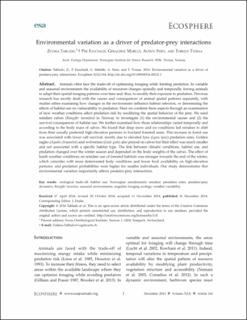Environmental variation as a driver of predator-prey interactions
Peer reviewed, Journal article
Published version

Åpne
Permanent lenke
https://hdl.handle.net/11250/3058077Utgivelsesdato
2014Metadata
Vis full innførselSamlinger
- Publikasjoner fra CRIStin - NINA [2364]
- Scientific publications [1392]
Sammendrag
Animals often face the trade-off of optimizing foraging while limiting predation. In variable
and seasonal environments the availability of resources changes spatially and temporally, forcing animals
to adapt their spatial foraging patterns over time and, thus, to modify their exposure to predation. Previous
research has mostly dealt with the causes and consequences of animal spatial patterns separately, with
studies either examining how changes in the environment influence habitat selection, or determining the
effects of habitat use on vulnerability to predation. Here we combine these aspects through an examination
of how weather conditions affect predation risk by modifying the spatial behavior of the prey. We used
reindeer calves (Rangifer tarandus) in Norway to investigate (1) the environmental causes and (2) the
survival consequences of habitat use. We further examined how those relationships varied temporally and
according to the body mass of calves. We found that deep snow and ice conditions led reindeer to shift
from their usually preferred high-elevation pastures to lowland forested areas. This increase in forest use
was associated with lower calf survival, mostly due to elevated lynx (Lynx lynx) predation rates. Golden
eagles (Aquila chrysaetos) and wolverines (Gulo gulo) also preyed on calves but their effect was much smaller
and not associated with a specific habitat type. The link between climatic conditions, habitat use, and
predation changed over the winter season and depended on the body weights of the calves. The effect of
harsh weather conditions on reindeer use of forested habitats was stronger towards the end of the winter,
which coincides with more deteriorated body conditions and lower food availability on high-elevation
pastures, and predation probabilities were higher for smaller individuals. Our study demonstrates that
environmental variation importantly affects predator-prey interactions.
Key words: ecological trade-off; habitat use; Norwegian semidomestic reindeer; predation rates; predator-prey
dynamics; Rangifer tarandus; seasonal environments; ungulate foraging ecology; weather variability.
